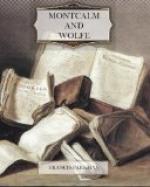New York had not as yet reached the relative prominence which her geographical position and inherent strength afterwards gave her. The English, joined to the Dutch, the original settlers, were the dominant population; but a half-score of other languages were spoken in the province, the chief among them being that of the Huguenot French in the southern parts, and that of the Germans on the Mohawk. In religion, the province was divided between the Anglican Church, with government support and popular dislike, and numerous dissenting sects, chiefly Lutherans, Independents, Presbyterians, and members of the Dutch Reformed Church. The little city of New York, like its great successor, was the most cosmopolitan place on the continent, and probably the gayest. It had, in abundance, balls, concerts, theatricals, and evening clubs, with plentiful dances and other amusements, for the poorer classes. Thither in the winter months came the great hereditary proprietors on the Hudson; for the old Dutch feudality still held its own, and the manors of Van Renselaer, Cortland, and Livingston, with their seigniorial privileges, and the great estates and numerous tenantry of the Schuylers and other leading families, formed the basis of an aristocracy, some of whose members had done good service to the province, and were destined to do more. Pennsylvania was feudal in form, and not in spirit; Virginia in spirit, and not in form; New England in neither; and New York largely in both. This social crystallization had, it is true, many opponents. In politics, as in religion, there were sharp antagonisms and frequent quarrels. They centred in the city; for in the well-stocked dwellings of the Dutch farmers along the Hudson there reigned a tranquil and prosperous routine; and the Dutch border town of Albany had not its like in America for unruffled conservatism and quaint picturesqueness.
Of the other colonies, the briefest mention will suffice: New Jersey, with its wholesome population of farmers; tobacco-growing Maryland, which, but for its proprietary government and numerous Roman Catholics, might pass for another Virginia, inferior in growth, and less decisive in features; Delaware, a modest appendage of Pennsylvania; wild and rude North Carolina; and, farther on, South Carolina and Georgia, too remote from the seat of war to take a noteworthy part in it. The attitude of these various colonies towards each other is hardly conceivable to an American of the present time. They had no political tie except a common allegiance to the British Crown. Communication between them was difficult and slow, by rough roads traced often through primeval forests. Between some of them there was less of sympathy than of jealousy kindled by conflicting interests or perpetual disputes concerning boundaries. The patriotism of the colonist was bounded by the lines of his government, except in the compact and kindred colonies of New England, which were socially united, through politically distinct.




